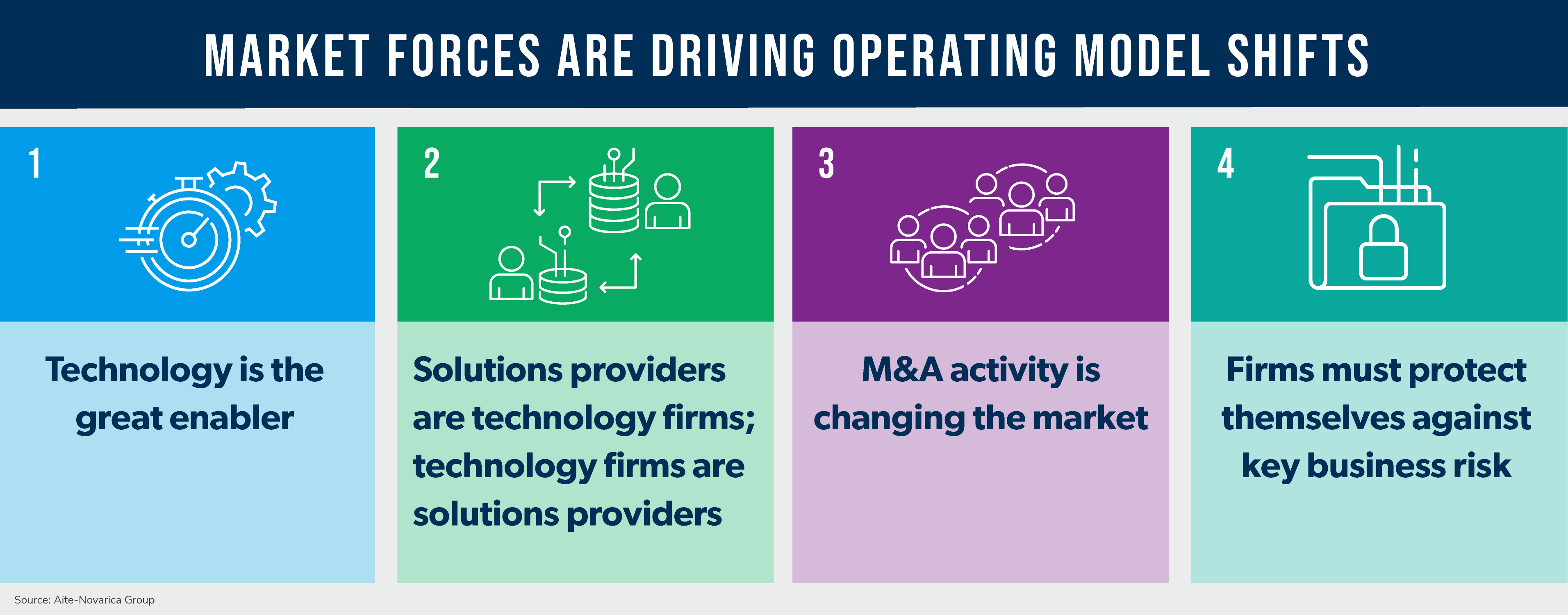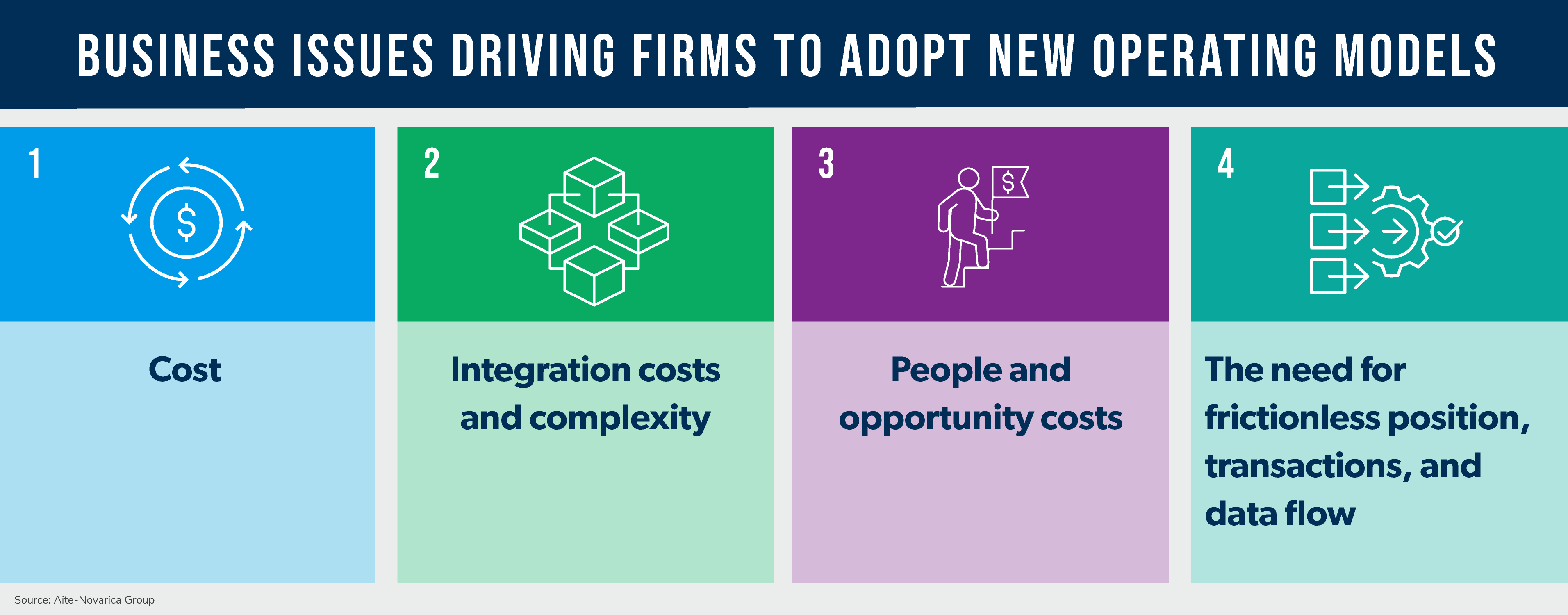In 2023, asset managers are facing amplified challenges due to volatile market conditions, margin pressure, looming shortened settlement cycles, increased regulatory requirements, and other industry-specific hurdles. These challenges are further compounded by the rapid pace of technological advancements and innovation, which bring both new opportunities and additional obstacles for managers to navigate. As a result, there is a growing imperative for asset managers to embrace change and adapt to these external factors.
Aite-Novarica Group has observed that leading firms are proactively responding to these challenges by increasing the frequency of due diligence reviews for their core technology and service providers, driven by a combination of evolving market dynamics and changes in the solutions landscape. These changes are being driven by four key macro-trends:
- Technology is the great enabler: ChatGPT may be the buzz-tech of 2023, but it is hardly the only technology enabling step changes in capabilities. The maturation of artificial intelligence (AI), robotic process automation (RPA), and integration tools has played a crucial role in accelerating the transformation of the competitive solution provider landscape.
- Solutions providers are technology firms; technology firms are solutions providers: The pace of innovation is relentless, with new capabilities being introduced almost daily. Notably, advancements such as State Street Alpha and BNY Mellon’s Data Vault have revolutionized the landscape, altering the cost benefit analysis of outsourcing and introducing a fresh set of capabilities to the market. As a result, technology providers have responded by opening core platforms to facilitate seamless integration with key outsourced providers by allowing them to operate within the client’s instance of a solution, such as BlackRock Aladdin’s Provider. These transformative measures exemplify the innovation occurring to meet the ever-evolving needs of asset managers.
- M&A activity is changing the market: Big acquisitions like the expected acquisition of SimCorp A/S by Deutsche Börse AG and ongoing consolidation of everything from ESG providers to analytics solutions are both creating new solutions capabilities and shifting vendor risk profiles. Understanding the implications of these tie-ups and their impact on a firm’s business is critical.
- Firms must protect themselves against key business risk: Most firms have completely moved away from in-house software development because it is not a core competency. Instead, they are relying heavily on an ecosystem of technology and solutions providers to help them create competitive differentiation. Reliance on third-party solutions creates critical business risk that firms need to understand, particularly with respect to control and ownership of data. Firms also need to ensure they have processes in place for business continuity planning in case key partners go down.

Each of the above alone creates an imperative to review the solutions landscape and its potential impact on a firm’s operating models. However, it is crucial to also consider the internal forces that compel firms to embrace change, namely the refocus on the core asset management business and the financial and strategic imperative to establish a streamlined, cost-effective investment operating model with reduced friction.
As a natural consequence, Aite-Novarica Group is seeing many firms look to rationalize and consolidate systems or outsource to a single provider who can offer broader capabilities. These shifts represent the biggest opportunity to optimize the operating model to create a lower cost, more dynamic business. Aite-Novarica Group sees four key internal drivers shaping the future of operating models:
- Cost: Operations and technology divisions account for around 15% to 20% of total costs across asset management functions, making them a target for cost-efficiency programs and rationalization efforts. Complex investment technology models are heavily skewed toward maintaining, but not improving, best-of-breed systems.
- Integration costs and complexity: The most complex firms have to integrate over 100 applications to support investment operations. Trying to manage the upgrade life cycles of these heavily interdependent applications to ensure a single upgrade does not break the entire tech stack compromises the resources necessary to improve the overall solution.
- People and opportunity costs: The explicit costs of the technology and implicit costs of people required to support integrating applications are significant, and increased technology complexity negatively impacts the business as implementing systems changes and enhancements is challenged by interdependencies.
- The need for frictionless position, transactions, and data flow: In a rapidly changing industry with shorter settlement cycles, asset managers must minimize data integrations and reconciliations internally. The modern operating model relies on being able to serve multiple needs, such as front-office, real-time, and settled cash requirements for accounting, either through a single system capable of handling multiple books of records or through streamlined system integrations. This approach provides a solid foundation for efficient operations and meets the demands of a dynamic marketplace. Consolidating systems and data not only increases accuracy but also reduces operational risks and enhances overall efficiency.

Aite-Novarica Group believes that there are three key takeaways from the changes happening in the asset management space:
- Firms need a strong data-centric foundation and vision for their future investment operations and technology.
- Asset managers require a robust solution and service provider governance program. Executive ownership, a clear mandate, and ample resources are vital for their success. With strong leadership, a defined framework, and sufficient allocation of resources, firms can effectively manage vendor relationships, mitigate risks, and maximize value from solution providers.
- Within that governance program, firms need to be benchmarking their tech stacks against competitive offerings and evaluating the cost and benefits of changing providers and/or deployment models.
The right business model requires the right mix of solutions providers and technology solutions. Aite-Novarica Group’s clients use our research and advisory capabilities to benchmark existing providers against competitive and challenger solutions.
To learn more about how we can help, reach out directly to set up some time together. You can contact me here or Paul Sinthunont here.